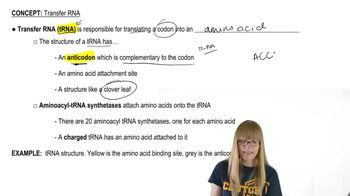In the experiments that deciphered the genetic code, many different synthetic mRNA sequences were tested.
Predict the results of experiments examining GCUA repeats.
The human mitochondrial genome encodes only 22 tRNAs, but at least 32 tRNAs are needed for cytoplasmic translation. How are all codons in mitochondrial transcripts accommodated by only 22 tRNAs? The Plasmodium mitochondrial genome does not encode any tRNAs; how are genes of the Plasmodium mitochondrial genome translated?
 Verified step by step guidance
Verified step by step guidance
Verified video answer for a similar problem:
Key Concepts
Mitochondrial tRNA and Codon Usage
Wobble Hypothesis

Alternative Translation Mechanisms in Plasmodium

You conduct a study in which the transcriptional fusion of regulatory sequences of a particular gene with a reporter gene results in relatively uniform expression of the reporter gene in all cells of an organism. A translational fusion with the same gene shows reporter gene expression only in the nucleus of a specific cell type. Discuss some biological causes for the difference in expression patterns of the two transgenes.
Several lines of experimental evidence pointed to a triplet genetic code. Identify three pieces of information that supported the triplet hypothesis of genetic code structure.
Outline the events that occur during initiation of translation in E. coli.
Describe the gene and protein defects in phenylketonuria (PKU). How are these defects connected to disease symptoms?
A portion of a DNA template strand has the base sequence 5′-...ACGCGATGCGTGATGTATAGAGCT...-3′
Identify the sequence and polarity of the mRNA transcribed from this fragmentary template-strand sequence.

